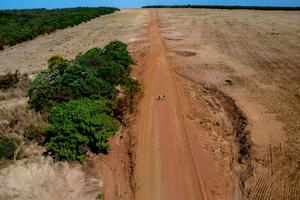Interior Secretary Ryan Zinke speaks prior to President Trump's signing of an executive order reviewing National Monument designations. REUTERS/KEVIN LAMARQUE
When he signed the executive order last month ordering Interior Secretary Ryan Zinke to review the status of these national monuments, Trump — alluding to Bears Ears — said, “The Antiquities Act does not give the federal government unlimited power to lock up millions of acres of land and water, and it’s time we ended this abusive practice. I’ve spoken with many state and local leaders … who are gravely concerned about this massive federal land grab.”
The federal government owns roughly 640 million acres of land, the vast majority of it in the West. The portions of Western states owned by the U.S. government — the Forest Service, Bureau of Land Management (BLM) , National Park Service, the Fish and Wildlife Service, and the Department of Defense — range from 29 percent of Montana to roughly 80 percent of Nevada. Nearly two-thirds of Utah is federally owned.
A cadre of Western politicians, ranchers, miners, and many others have railed against federal land management for decades, claiming laws like the Endangered Species Act and the Federal Land Policy and Management Act— which require the BLM to focus not only on resource extraction but also on environmental and other values — are onerous. These Westerners have long demanded that the federal real estate portfolio, or a large portion of it, be given to the states to help boost resource development, among other things.
An earlier manifestation of this movement was the so-called Sagebrush Rebellion in the late 1970s when Western legislatures introduced a series of bills to claim federal land. But the movement fizzled when Ronald Reagan, a friend of the rebellion, was elected president and his Interior Secretary, James Watt, shifted federal land management more in favor of resource extraction.
The designation of Bears Ears and other national monuments has lit the fuse of rebellion again. And Utah is ground zero for a movement to overthrow the federal landlord. Senator Orrin Hatch, a leader of the first Sagebrush Rebellion, is a major player in this one as well, urging Trump to undo and otherwise shrink monument designations.
The consensus of many experts, though, is that the outcome many states-rights rebels dream of — the transfer of vast tracts of federal lands to state and private hands — is going nowhere, even with Republicans in control in Washington. In part it’s because the land would simply be too expensive for states to manage. For example, the U.S. Forest Service spent $1.7 billion on fire suppression in 2015. “The only way the states are going to meet the cost is to sell a lot of it,” said John Freemuth, a professor of public policy at Boise State in Idaho and an expert on public lands. “States are not equipped.”
In any case, it’s unlikely that vast tracts of public land would be transferred to states. When Utah Congressman Jason Chaffetz introduced a bill in January to sell 3.3 million acres of public lands across the West, the outcry and pushback from thousands of sportsmen, recreation interests, environmentalists, and others was enormous. Chaffetz hastily withdrew his bill.
`We are very concerned about efforts by states to rip [public lands] away from the American people,’ says an outdoor industry official.
The Outdoor Industry Association — whose members account for more than $887 billion in consumer spending — was among the ardent opponents. “We all universally in the industry view those as hostile acts,” said Alex Boian, vice president for government affairs for the association. “We are very concerned about efforts by states to rip them (public lands) away from the American people.”
Legal experts also say that a revocation of national monuments is unlikely. A study to be published in the Virginia Law Review by four law professors contends there is no language in the act that gives Trump the authority to undo designated monuments. “Congress alone, and not the President, has the legal authority to eliminate or shrink national monuments,” wrote Sean B. Hecht, one of the authors of the paper.
But even though a large-scale revocation of national monument lands may not be in the cards, experts say the Trump administration and advocates of loosening federal control over Western states can take numerous steps to weaken environmental protections and open the door to more extractive activity on public lands, including national monuments.
“The most potent strategy that they can use to affect change is the budget,” said James R. Lyons, who was a deputy assistant secretary in the Interior Department under the Obama administration and is now a research scholar at the Yale School of Forestry & Environmental Studies. “The battle lines are drawn as they look at the 2018 budget. They have proposed a skinny budget, with dramatic cuts in the EPA, the Department of Agriculture, Interior, and elsewhere. There’s a lot of talk about priorities and programs and what should be dropped. Should the Forest Service and BLM be combined, or the Forest Service be put under Interior? It’s all part of the dialogue.”
Trump’s proposed public lands budget, released last week as part of the overall budget, would open many federal lands to a major environmental assault, critics say. The Trump budget proposes opening the Arctic National Wildlife Refuge (ANWR) — a 30,000-square-mile Alaskan wilderness — for oil and gas exploration in the next five years. It remains uncertain whether Congress will approve opening the refuge to fossil fuel drilling, but the prospect has deeply alarmed conservationists and indigenous people who live in ANWR.
“For us protecting this place is a matter of physical, spiritual and cultural survival,” said Bernadette Demientieff, a spokeswoman for the Gwich’in native people.
The administration is eliminating restrictions on coal leasing and oil and gas development on public lands.
The Trump administration is making many other changes, especially to energy policy — despite the fact that the country is awash in oil and gas. Shortly after becoming Interior secretary, Zinke removed an Obama-era moratorium on coal leasing on federal lands. The administration is also eliminating or “streamlining” restrictions on oil and gas development on public lands. Lyons, who worked at the BLM on the Master Leasing Program — an effort to minimize energy development in environmentally sensitive or culturally significant areas — fears that program will be abandoned.
“Their priority is easy access to oil and gas production, despite the fact that only 40 percent of the leases [on federal lands] are in production,” said Lyons. In some places the leases are selling for as low as $2 an acre because of low demand for oil and gas.
One of the first steps Trump took was eliminating regulations that limited leaks of methane — a greenhouse gas far more potent than CO2 — from oil and gas operations on public lands. Trump used the Congressional Review Act, which allows him within 60 days of taking office to undo executive actions issued in the final months of the Obama administration. The Senate, which must agree to the president’s action, rejected the decision on methane leaks by a narrow margin, but observers expect the administration to accomplish its goal through new rules.
The Interior Department has also suspended all of its Resource Advisory Councils, which are citizen groups that advise BLM managers on how public lands should be managed. And one of Zinke’s first acts was to bring back to federal lands lead shot for waterfowl hunting. Many hunters say it has better killing power than steel. Lead shot was banned in 1991 because it kills millions of non-target birds and other animals that ingest the shot and die of lead poisoning.
Lyons says a substantial change to public land policies could come from the ascendance of Neil Gorsuch, the president’s pick for the U.S. Supreme Court. Lyons specifically cited Gorsuch’s view on something called the “Chevron deference,” a Supreme Court decision stating that courts must generally defer to the expertise of federal agency managers when interpreting federal law. But when two court cases on this issue came before Gorsuch — then a U.S. District court judge — Gorsuch said the decision gave too much deference to the agencies. Lyons said that if, for example, the BLM decides to prohibit drilling in a certain locale, and the usual deference to such a decision is eliminated because the Supreme Court scraps the Chevron deference, it could allow drilling to proceed on some federal lands.
Conservation groups are now gearing up to fight the various budget and administrative actions being taken by the Trump administration. Preventing federal lands from being sold, they say, would be a victory, but would only be the start of the fight.
“They will remain public lands,” said Land Tawney, the president and CEO of Backcountry Hunters and Anglers in Missoula, Montana. ”But we need quality habitat and quality experience to go along with that.”
Gray wolves were reintroduced in Yellowstone National Park under the Endangered Species Act, which congressional Republicans are seeking to overhaul. STEVE JURVETSON/CREATIVE COMMONS
Meanwhile the Endangered Species Act (ESA), long a boogeyman for conservatives, may soon be overhauled by the Republican-controlled Congress, backed by the Trump administration. The return of wolves to six Western states and the fact that the greater sage grouse came close to being listed across a vast swath of public lands in 11 Western states are two of the most recent controversies involving the ESA. That’s why Senator Rand Paul of Kentucky and Senator Dean Heller of Nevada — a state that just recorded its first wolf sighting since 1922 — have introduced a bill, the Endangered Species Self Determination Act, to reform the ESA by only allowing a species to be listed with congressional approval, and automatically de-listing a species after five years. It would also mandate that endemic species that fall entirely within one state’s border must be managed by that state and not federal biologists.
“Nevadans — not Washington bureaucrats — know how to best protect the sage grouse,” Heller said.
Under current ESA rules, federal scientists, primarily at the U.S. Fish and Wildlife Service, make a determination as to whether a species should be listed as threatened or endangered, and scientists also determine when a species should be removed from the list. Heller’s proposal would politicize decisions about endangered species, critics say.
Of course it’s still early in this administration and volatility abounds. But whatever happens, environmentalists say, could pose a threat to the environmental progress of the last half-century.
“We didn’t always agree with the Obama Administration, in fact sometimes we were surprised by them,” said Matt Bishop, who litigates endangered species cases for the Western Environmental Law Center in Helena, Montana.”But now it’s going to be the fox guarding the henhouse, only worse.”




